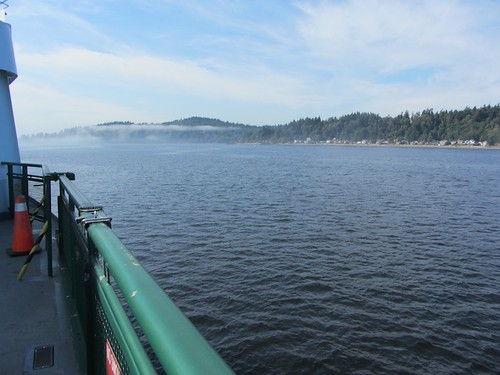 |
| Sitka Waterfront |
 |
| Sitka National Historical Park |
On our last day in Alaska, we visited the Alaska Raptor center, the Sitka National Historical Park, and for a short time, the town itself. At the end, we had around 15 minutes inside the Russian Orthodox cathedral of Sitka. The historical park had made us aware of the history of the Russians during the 100 years or so before they sold Alaska to the US in 1867, which was lucky since there was no time to learn much about the cathedral, other than that this building replaced one that burned, along with much of the downtown, around 50 years ago. And that the icons, including one with a miraculous history, were mainly saved from the fire.
 |
| Russian Orthodox Cathedral, Downtown Sitka |
Other than a very short walk in Juneau the first night of our trip this was the only time we experienced the tourist shops and many souvenir opportunities that are standard on most cruises. Some of the merchandise was appealing, including some of the carving in whale bone. We only bought a reproduction of a painting by one of the naturalists from the boat, who sells in a gallery in Sitka. She was there and signed it for us.
The only thing I ever read about Sitka before the trip was
The Yiddish Policemen's Union by Michael Chabon. It's not about real Sitka, but about a counterfactual Sitka that was settled in the 1950s by Jews whose alternate reality had caused them to be barred from creating the state of Israel. A wonderful book -- but not really relevant.
John Muir's last trip to Alaska was in 1890. While his travels around a decade earlier had been in very rough conditions, by this time there were many tourists in purpose-built cruise ships of that era, and he traveled at least part of the time in much more comfortable conditions. Here is one day's journal entry from 1890 that I found especially charming:
July 7. Another fine day; scarce a cloud in the sky. The icebergs in the bay are miraged in the distance to
look like the frontal wall of a great glacier. I am writing letters in anticipation of the next steamer, the
Queen.
She arrived about 2.30 P.M. with two hundred and thirty tourists. What a show they made with their
ribbons and kodaks! All seemed happy and enthusiastic, though it was curious to see how promptly all of
them ceased gazing when the dinner-bell rang, and how many turned from the great thundering crystal
world of ice to look curiously at the Indians that came alongside to sell trinkets, and how our little camp and
kitchen arrangements excited so many to loiter and waste their precious time prying into our poor hut.
 |
Alaska Raptor Center: this bald eagle can't fly, but he's calm when faced with a crowd of tourists.
All today's photos are by Len. |



































